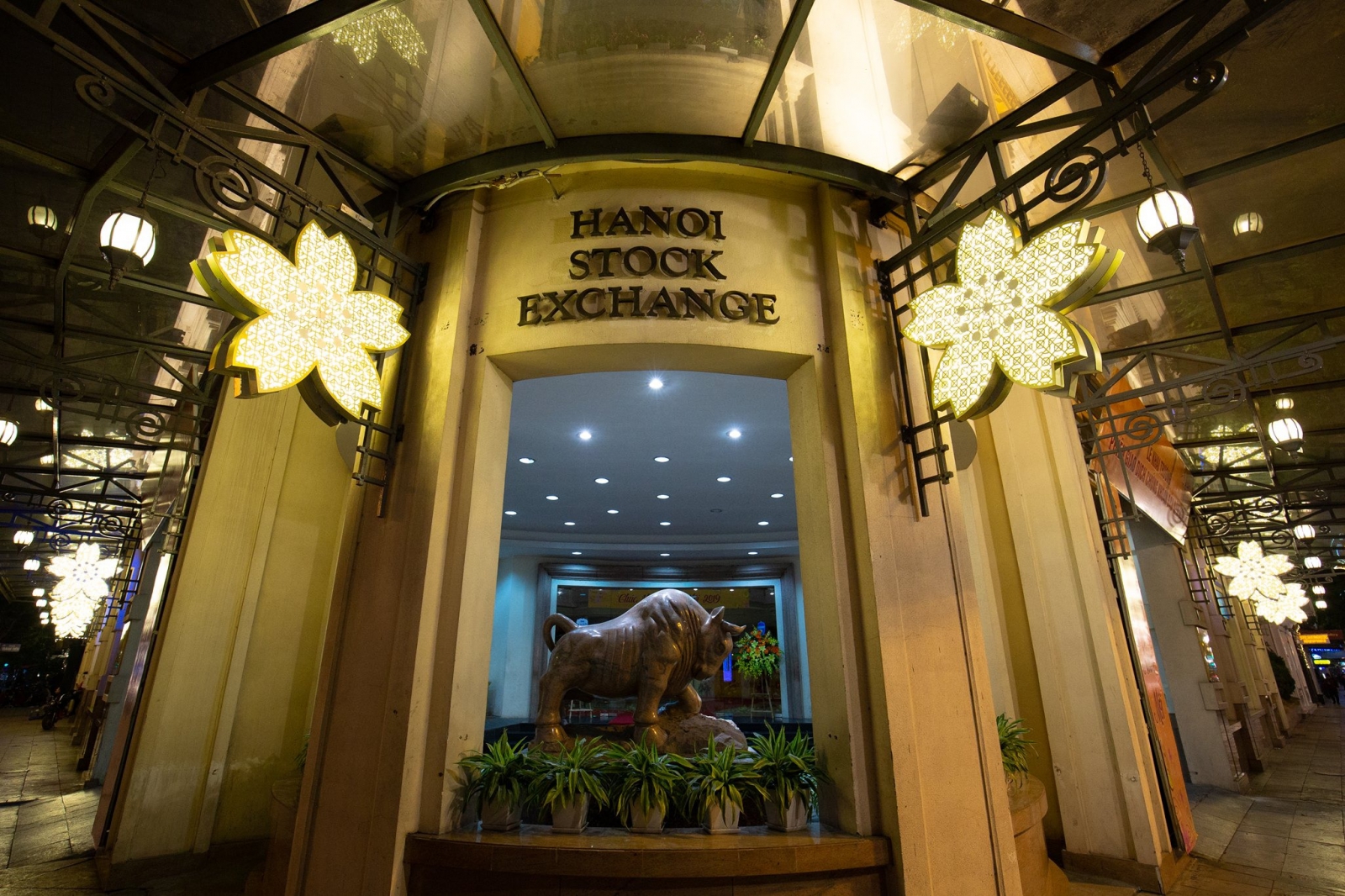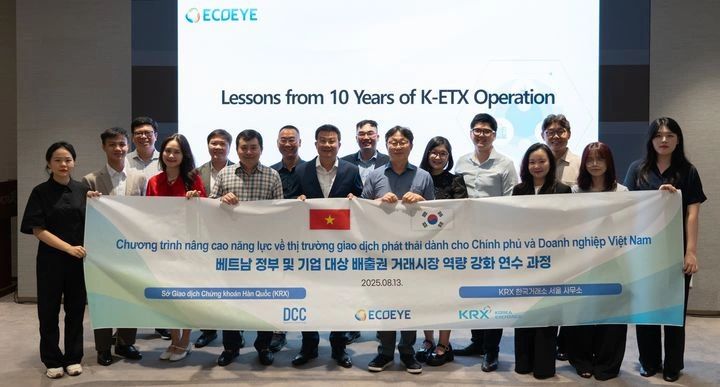
Hanoi Stock Exchange develops carbon trading platform for Vietnam's carbon market, with first transactions expected by year-end.(Photo: Hanoi Stock Exchange facebook)
Since the release of the long-awaited Decree 119/2025 which fleshes out details related to the establishment and operation of Vietnam’s carbon market on 9 June, the Southeast Asian country has been harnessing efforts in preparing for the pending trading commencement under Hanoi Stock Exchange – the designating carbon trading platform of Vietnam’s carbon market.
The national carbon registry remains underdeveloped. Vietnam’s government has been actively strengthening cooperation and absorbing experiences from implementing emissions trading system (ETS) in three East Asian carbon markets, namely South Korea, Japan and China.
Regulatory status of Vietnam’s carbon market
Decree 119/2025 is the revised version of Decree 06/2022 on Mitigation of Green House Gas (GHG) Emissions and Protection of Ozone Layer, which can be considered as the first official and overarching legal framework for the implementation of carbon markets in Vietnam. Throughout 2024, the country issued several revised drafts of Decree 06/2022 in April, August and November. The official revised version (Decree 119/2025) largely confirms the contents of the November draft, which articulates the use of 30% offset credits (from both domestic and international projects aligned with Article 6 of the Paris Agreement) and a clear timeline for the development of Vietnam’s ETS (pilot phase until the end of 2028 and national phase from 2029 onwards). Further details can be found in our previous article here.
Since the release of Decree 119/2025 in June, no trading takes place under the Hanoi Stock Exchange. Initially scheduled for mid-June, the delay of trading commencement was announced by the Ministry of Agriculture and Environment (MAE) in late July, that the first transaction should be expected to occur by the year end.
The lack of trading rules and the absence of a national carbon registry are the main reasons for this delay. In March 2025, the first draft of a separate decree regarding the role of the Hanoi Stock Exchange and trading regulations was released. Vietnam’s Ministry of Finance has been gathering public consultations and revising the first draft – the whole progress will take many months and before its completion, market participants lack rules to engage in trading activities.
Furthermore, the MAE has been still underway preparing for the launch of the national carbon registry, which will provide a digital system to handle registration, issuance and cancellation of carbon credits, thereby guaranteeing the transparency and effectiveness of Vietnam’s carbon markets. In the latest move, the United Nations Development Programme (UNDP) in March provided support to the MAE in hiring a local IT firm to help launch the demo version of this national carbon registry.
A new focus on forestry carbon trading
In parallel, Vietnam’s government has been actively building legal frameworks for domestic and international carbon trading, with a strong focus on forestry carbon projects.
With approximately 15 million hectares of forests, Vietnam is expected to become a promising supplier of the voluntary carbon markets. Yet, international trading of Vietnam’s carbon credits has been quite limited so far. There was only one transaction between Vietnam and World Bank back in 2023, under which up to 95% of Vietnam’s carbon credits were counted towards Vietnam’s NDC.
In mid-June, Vietnam released the first draft decree on forestry carbon credits. Offset projects related to forestation have been traditionally faced with several issues such as the lack of evidence for additionality and challenges in verifying land eligibility and forest rights. The decree is expected to help resolve these problems and at the same time shed light on how Vietnam will align domestic rules with Article 6 of the Paris Agreement. Specifically, Article 10 of the draft decree outlines that MAE will take responsibility for issuing Letters of Authorisation (LoAs) – only credits that get LoAs are allowed to trade in the form of Internationally Transferred Mitigation Outcomes, or ITMOs, under Article 6. The rest will be used towards Vietnam’s NDC and cannot be traded as ITMOs.
LoAs are part of rules on corresponding adjustments under Article 6 of the Paris Agreement. Corresponding adjustments are an accounting mechanism under Article 6 of the Paris Agreement which require selling country to prevent the double-counting of their emission reductions. Their emission reductions when being transferred internationally - called ITMOs should not be at the same time counted as the selling countries’ NDC. To guarantee that, selling countries need to issue LoAs which confirm that they will remove these carbon credits from their own NDCs.
Vietnam’s competent authorities are working on revising the first draft decree. The government aims to issue the final draft in September, and the official version will be release in early 2026.
Cooperation with East Asian countries
From 11 to 15 August, Vietnam organised several meetings with Ecoeye, a Seoul-based GHG investment company which offers the South Korea’s first integrated carbon market information platform. Ecoeye aimed to design capacity building trainings to Vietnam’s officials from Department of Climate Change (DCC) at MAE and Hanoi Stock Exchange, as well as local private consulting firms.
“Both DCC and Ecoeye confirmed their willingness to cooperate on carbon market development… The two sides discussed the long-term possibility for linking both markets after 2030”, an official from MAE told RECCESSARY. Regarding bilateral cooperation under Article 6 of the Paris Agreement, both sides recognised that many difficulties still lay ahead. As revealed by the MAE’s official: “The two sides agreed to maintain regular exchange channels, expand technical training cooperation and prepare legal and technical foundations for long-term goals, including a research plan for market connectivity after 2030”.

Ecoeye, South Korea’s carbon information platform, delivers technical training for Vietnam’s carbon market. (Photo: Ecoeye)
However, the first national ETS in East Asia - South Korean carbon market has been struggling with the oversupply issue for the preceding years, with many auction sessions being canceled early this year due to the lack of market demand. Since mid-August, South Korea’s Ministry of Environment has held information sessions to present the drafted Allocation Plan for the Fourth compliance period (2026-2030), which will likely change the existing rules on banking allowances and auction to reform the national scheme.
On 22 July, MAE and Japan’s Ministry of Environment co-hosted a forum called “Promoting Business Engagement in the Joint Crediting Mechanism (JCM) in Vietnam towards Readiness for Vietnam’s Carbon Market”. The forum facilitated cooperation between both countries on the progress of developing legal infrastructure for implementing Vietnam’s carbon market, as well as to explore future potential of JCM projects in Vietnam. As mentioned by Satoru Iino, Director of JCM and Internal Carbon Market Office at Japan’s Ministry of Environment, amongst the existing countries which have JCM cooperation, Vietnam has 23 approved JCM methodologies, only second to Indonesia with 29 methodologies.
Earlier this year, in March, Vietnamese delegations visited the Shanghai Environment Energy Exchange – the trading platform of the Shanghai ETS’s pilot and China’s national ETS. The timing of the meeting roughly coincided with the release of China’s official plan for the initial scope expansion of its national ETS to the cement, steel and electrolytic aluminium industries. Both the cement and steel sectors are included under Vietnam’s ETS from the pilot phase.
Are Vietnam’s industries ready and what are the next steps?
On 8 August, during a training session co-hosted by international consultancy MJA Climate and Energy, Eurocham and World Resource Institute, Vietnam’s industrial representatives broadly voiced support for the release of Decree 119/2025. Meanwhile, confusions remained regarding the allocation plan, MRV rules, timeline for introducing carbon standards and their alignment with Article 6 of the Paris Agreement.
The pilot phase which will last until the end of 2028 is anticipated to regulate over 150 entities from the power, steel and cement sectors, covering around 50% of Vietnam’s total emissions. According to the 2024 EDGAR report, Vietnam’s total emissions reached around 524 Mt.
Vietnam’s industrial readiness to participate in Vietnam’s carbon markets has been revealed to be relatively low. The 2025 survey report conducted by Energy Transition Partnership and DCC indicates that only one-third of Vietnam’s companies had conducted an emissions inventory, while below 11% had already had their emissions reports verified by a third party. This survey shows a strong consensus amongst Vietnam’s industries regarding the need for the government to organise capacity-building trainings for them.
In the upcoming months, Vietnam will likely continue to strengthen capacity building and focus on helping companies adapt to carbon trading system. In parallel, at a governmental level, the MAE will continue to strengthen its efforts to launch national carbon registry and trading commencement under Hanoi Stock Exchange. According to Decree 119/2025, the first batch of allowances will be allocated to covered companies by the end of this year. Until then, a clear allocation plan and detailed set of trading rules and MRV guidelines should be rolled out.
Related Articles》Vietnam launches emissions trading pilot amid doubts over effectiveness
This column is a collaboration between RECCESSARY and Mai Duong. All rights reserved. Reproduction without permission is strictly prohibited.
Have insights on energy or carbon issues? Share your perspective with us! Send your submission to reccessary@gmail.com for a chance to be featured. Submissions may be edited for clarity and style.
.jpg)